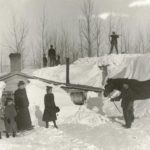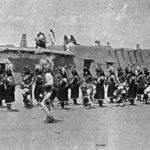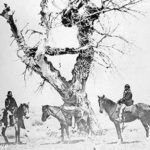In most earlier cultures, life slowed during the winter months; people could not plant seed in frozen ground, days were short and dark, and most agricultural tasks were complete. As in today’s practice of contemplation at the New Year, native peoples used winter as a time to reflect on the important events of the previous year.
Tribes such as the Sioux would pick an important event as the defining element of a year, and represent it pictorially on an animal hide. This practice is called a “winter count.” Years of great sickness, traumatic events, significant hunts, and so on could be remembered long after they happened.
Dr. Thomas Red Owl Haukaas created the Carnegie Winter Count of events affecting his tribe,the Sicangu Lakota people (Rosebud Reservation in South Dakota) from a 1990s viewpoint.
Here are a few of his interpretations:
1868–1869: Touched-the-Pen Winter
The Great Sioux Reservation was created with the signing of the Treaty of 1868. In exchange for some of our land, the Congress promised our people protection, annuities, education, and health care.
1872–1873: Metal-Horse-Attack Winter
The building of the railroad through Indian hunting grounds coupled with the flood of non-Indians onto Indian lands led to Indian retaliation.
1875–1876: Winter They Came like the Grasshoppers
Gold diggers flocked to the Black Hills even though the hills belonged to the Lakota. The U.S. Army did not enforce its treaty promise to protect Lakota property rights.
1898–1899: Really-Glad Winter
We should be very glad we weren’t moved to Oklahoma. Congress passed the Curtis Act, which destroyed all tribal jurisdiction and self-government there.
1900–1901: Winter of Disbelief
A U.S. Agent rented out tribal land to non-Indian ranchers in spite of a tribal moratorium against land rental.
Many thanks for these observations, courtesy of Dr. Haukaas and the Carnegie Museum of Natural History.







